Skip the boring old pumpkin pie—this unique twist on a traditional Greek dessert is the show-stopping Thanksgiving dessert you’ve been looking for!
With crispy, ruffled layers of phyllo dough on top and a custardy, bread pudding-like interior infused with pumpkin and spices, this ruffled milk pie is a textural experience unlike anything you’ve ever had before.
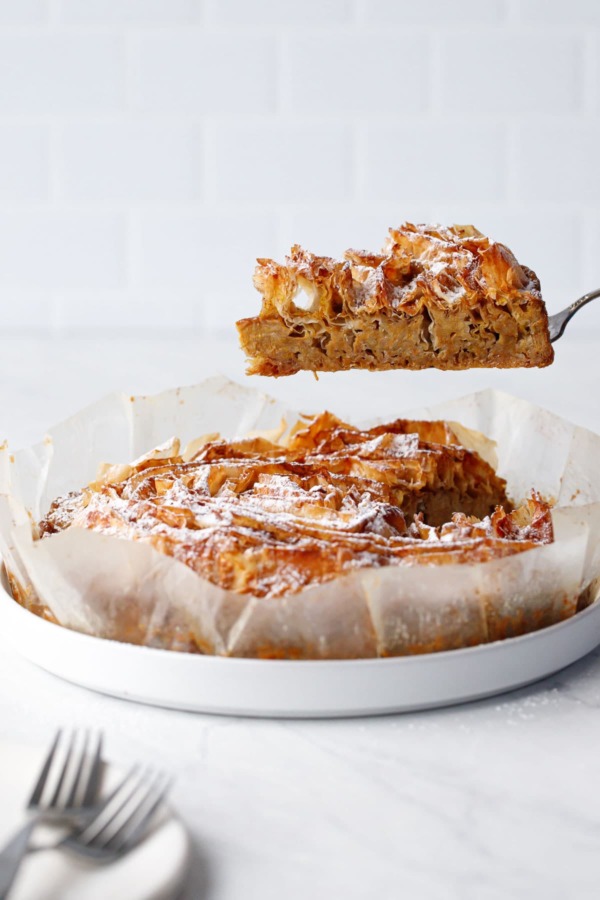
The most unusual twist on pumpkin pie yet?
Perhaps.
This pumpkin-spiced ruffle milk pie gives me all the feels. I mean, talk about a stunning dessert with surprisingly little effort (I’ll take phyllo dough over pie crust any day).
Ruffled milk pie has Greek origins, known also as galatopita (literally ‘pie made with milk‘), made from layers of flaky phyllo dough and a sweet milk and egg custard. This version adds pumpkin and spices for a festive twist that will no doubt make an impression on your Thanksgiving table.
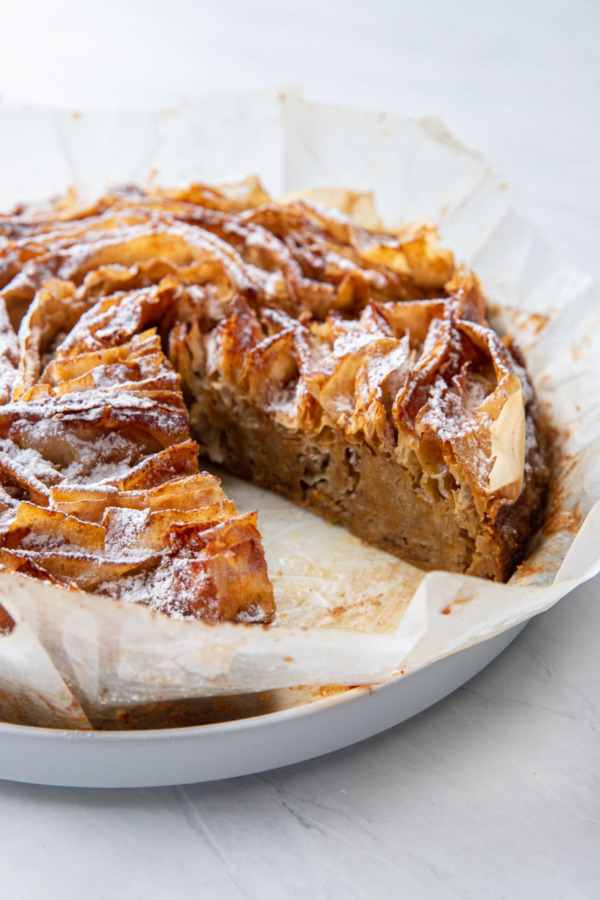
It’s really hard to compare galatopita to anything else in the American dessert repertoire. For those of us who’ve never had the original Greek version before, I would describe it as something like a phyllo bread pudding, with a crispy top and a soft and creamy, yet slightly chewy center.
The texture reminded me a lot of the dish called štruklji that we enjoyed in Croatia and Slovenia this past spring (in Slovenia it was a sweet version, steamed phyllo filled with an orange-scented chocolate sauce, while in Croatia it was savory, baked with fresh farmers cheese). But the texture of the steamed phyllo is very similar to what you end up with here when the phyllo bakes within the milk custard.
I infused the milk custard with pumpkin puree and pumpkin spices (enough to be brightly flavored, but not so much spice that the delicate flavor of the milk custard and buttery phyllo get overpowered). With a brush of honey butter and a dusting of powdered sugar on top, it’s the perfect amount of sweetness to balance out the more savory nature of the phyllo itself.
The top of the ruffled phyllo dough turns golden brown and gorgeously crispy in the oven, while the base softens within the silky sweet, lightly spiced pumpkin custard.
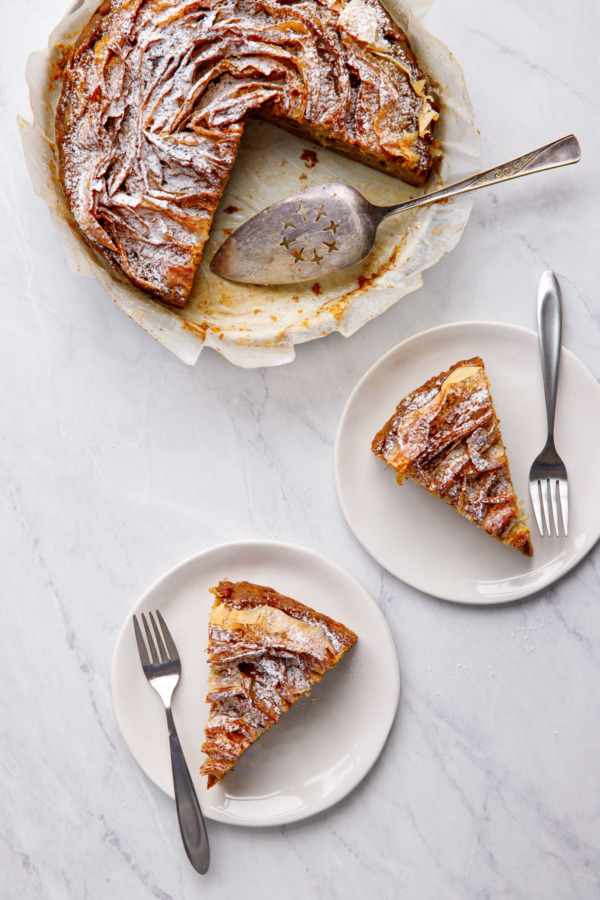
I will say this: some people might not like this pie, mainly because the texture of it is so unexpected and unusual. Soft baked phyllo dough is interesting, to say the least, and not what you expect when you see that beautiful crispy topping.
The two phyllo-based dishes most Americans are familiar with are baklava and spanakopita, and this pie isn’t anything like either of them.
So keep an open mind… and maybe make a second dessert to serve alongside this one (might I suggest this Pecan Fudge Pie? It’s a sure crowd-pleaser.)
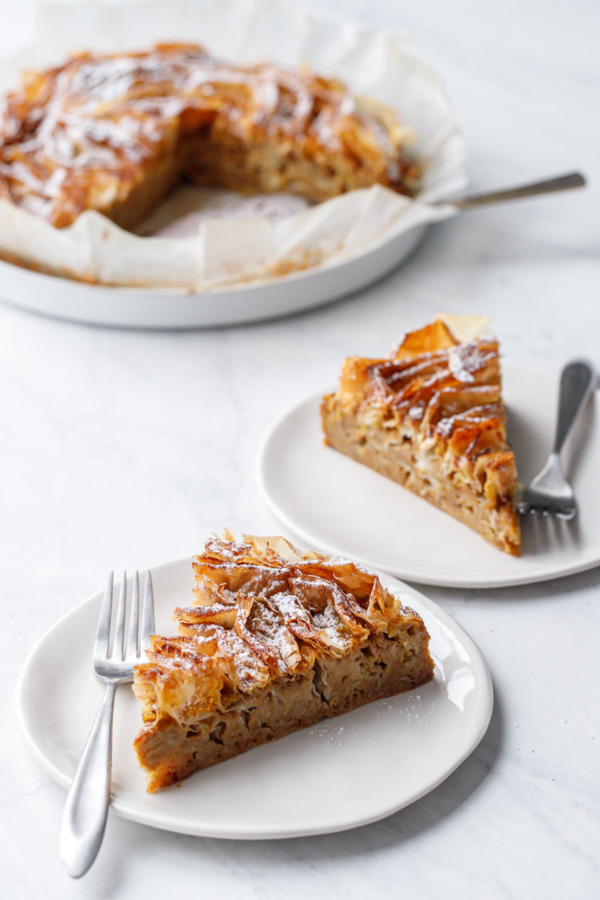
My first attempt was a bit more tightly wound in the center and looser around the edges, meaning most of the custard ended up on the outside and very little in the center. My first bite was pretty gross, actually, mostly soggy, unsweetened phyllo, but I noticed the taste improved as I got out towards the edge where there was more sweet spiced custard.
For attempt #2 I made sure to evenly distribute the custard, pouring it over top of the par-baked phyllo, making sure it flowed into all the little nooks and crannies, especially towards the center. I also forced a few more sheets of phyllo around the edges, since the phyllo does have a tendency to collapse inwards as it bakes. Finally, I balanced the sweetness of the non-custard areas by mixing in a little honey with my final brushing of melted butter (this addition is anything but traditional but I felt it really helped with the overall balance and sweetness).
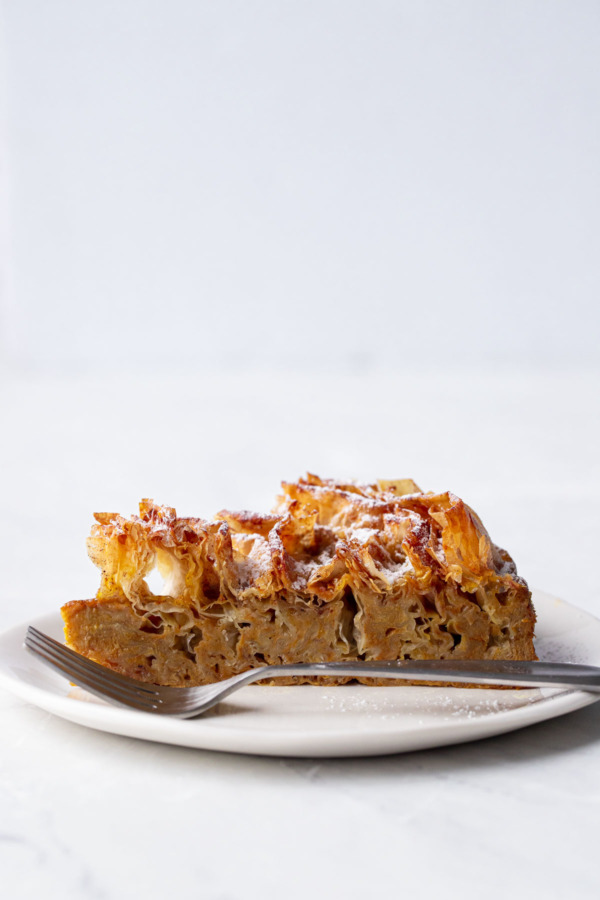
As for the folding/ruffling technique: you want to fold your phyllo dough like an accordion, with folds tall enough to match the deepness of your pan. For me, with a 9-by-2-inch pan and 9-by-14-inch sheets of phyllo, that meant about 2 1/4-inch folds.
Basically, I brushed one side of the dough with butter, then pinched it about a quarter of the way up the sheet, essentially making two folds at once. Then I pinched it where the first fold ended, and lifted, thus folding the last quarter of the dough down, forming something like an “M” shape.
If your phyllo sheets are larger you’ll be able to get more folds from a single sheet, meaning you’ll need fewer sheets to fill up the whole pan.
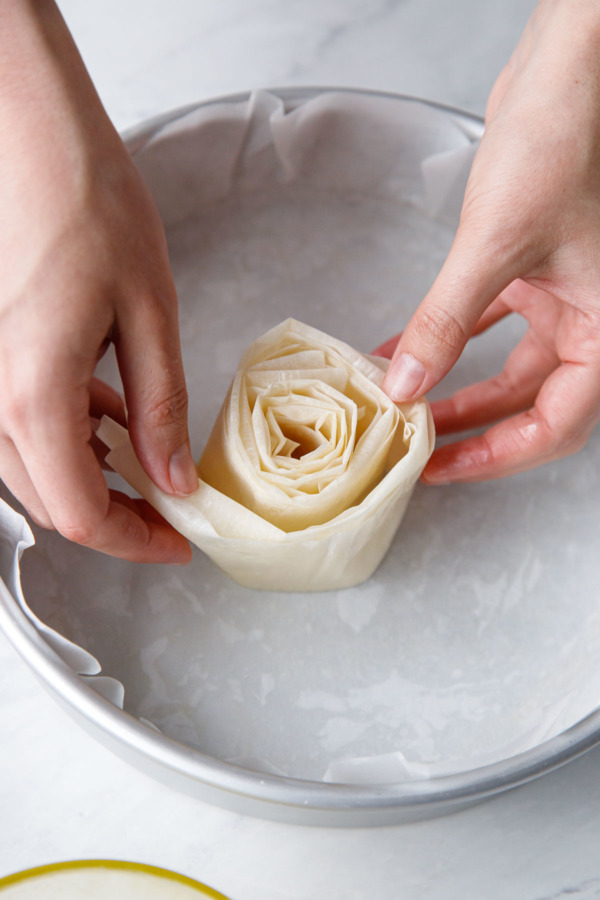
Once I had my dough folded to an M, I then flipped it (forming a W) so that the raw edges were facing up (this enhances the beautiful ruffly appearance).
For the first piece, roll it up gently into a spiral and place it in the middle of the pan. From there, I placed each subsequent folded piece so it continued the spiral all the way to the edges of the pan. The dough will collapse inward a bit as it bakes, so if you can pack one or two more pieces around the very edge to keep it looking full.
I went with a single spiral design, but I’ve seen versions of this pie with multiple small rosettes instead of one big one. Either way would work here (I could see the small rosette design being easier to serve as you wouldn’t need to cut through any phyllo dough, just serve one rosette per person).
Before baking, the raw phyllo dough gets another brush with butter (which I mixed with a bit of honey to even out the sweetness of the top) as well as a dusting of cinnamon. Bake until the phyllo is golden brown and crispy, then add the custard and bake it again until the custard is set.
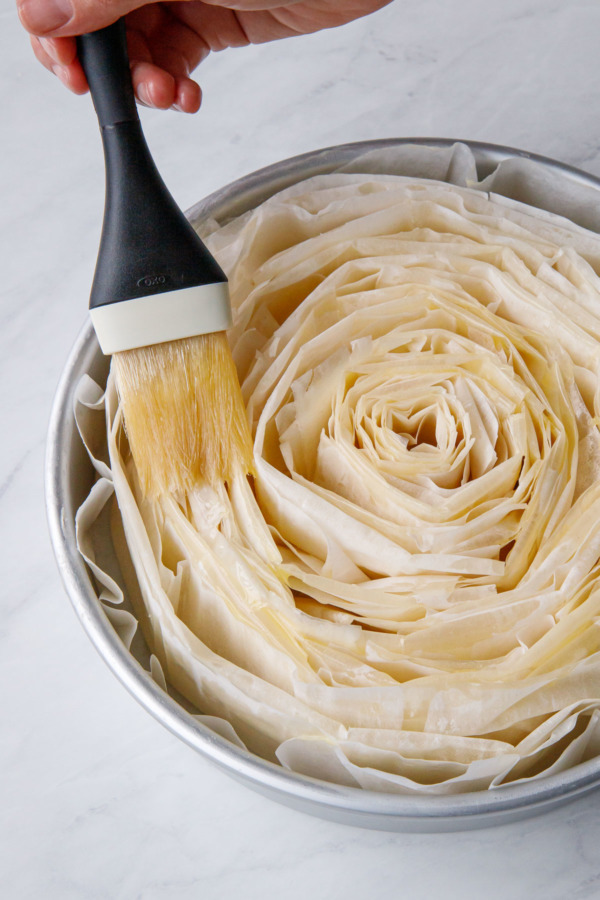
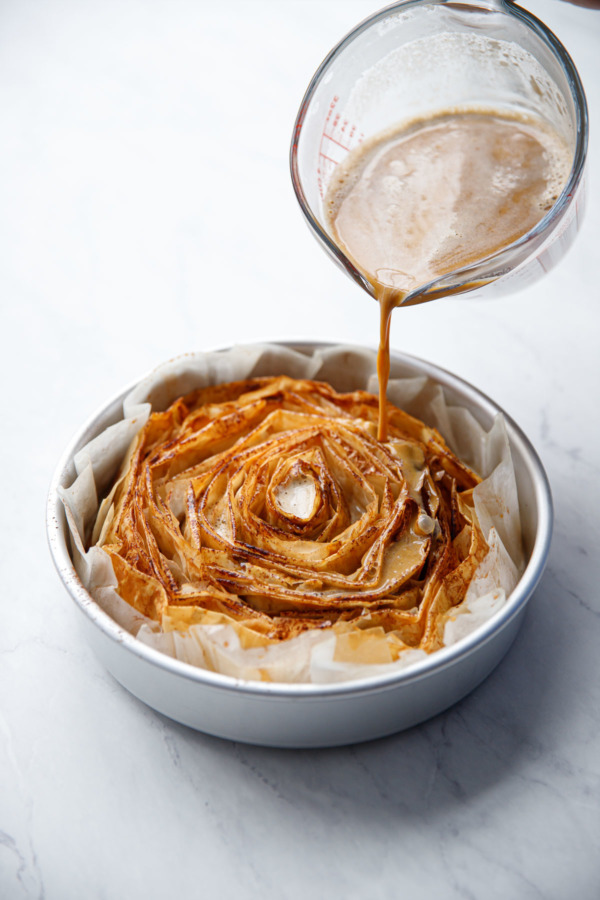
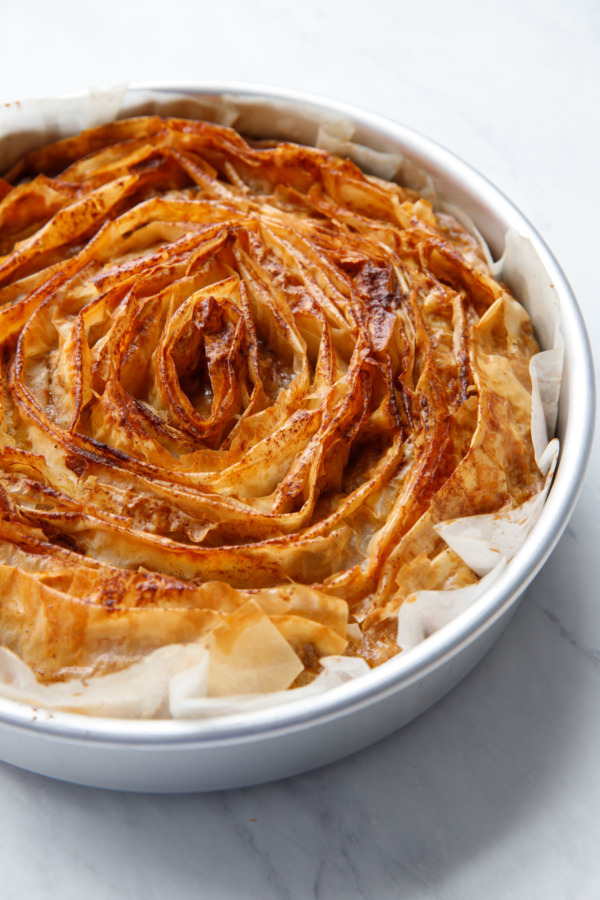
I know many of you will see the words “phyllo dough” and go running for the hills. But let me say, this is not a hard recipe. Ruffling the phyllo takes no longer than making a pie crust, and it is certainly no place for perfection. In fact, the more imperfect the better. So when your phyllo rips and tears and your spirals don’t cooperate, just keep going—your pie is going to be absolutely stunning regardless.
Tips for working with phyllo:
- Completely thaw it beforehand. If your phyllo is frozen, let it thaw in the fridge overnight, then take it out about 30 minutes before you are going to use it. There is no shortcut to thaw frozen phyllo, so don’t even try.
- Use clarified butter. I was astounded at the difference clarified butter (or ghee) makes when working with phyllo. Something about the extra water/milk solids in regular butter that makes the phyllo softer and extra fragile. So either buy a jar of ghee or take the extra 15 minutes to make your own clarified butter first.
- Keep it covered. Only one sheet of phyllo (the one you are working with) should be exposed at a time. The rest should remain covered so it doesn’t dry out. I like to use a piece of waxed paper covered by a slightly damp tea towel.
- Go big. If you can, large sheets of phyllo will speed up your process. I used smaller 9×14 sheets, and you just need more of them to completely fill the pan.
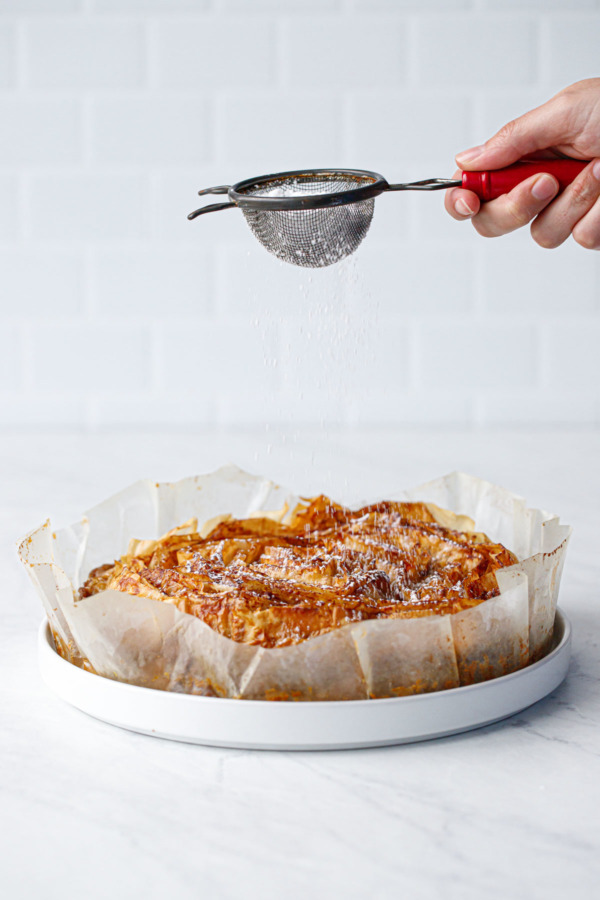
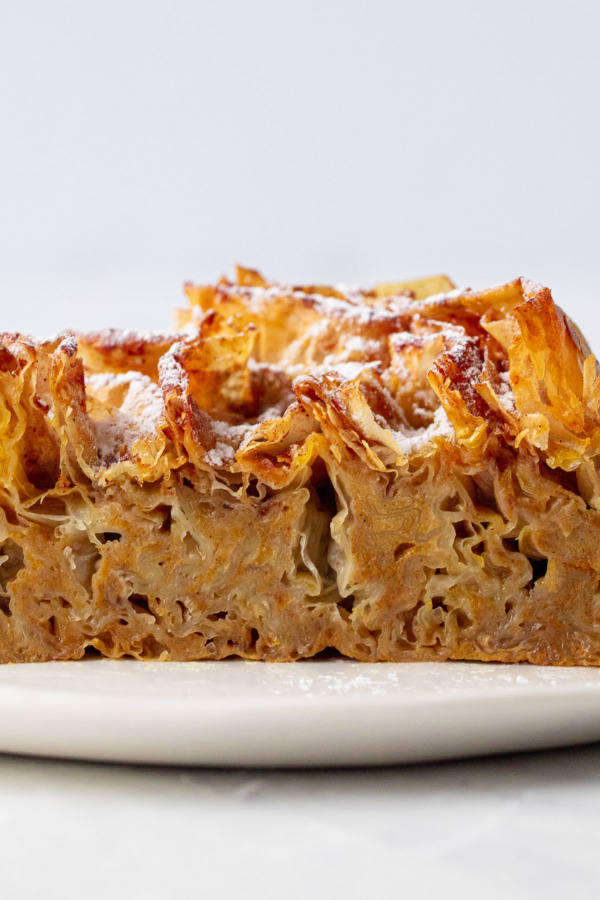
Unfortunately (and I know I’ll get asked so I wanted to address this up front) this recipe is not really a make-ahead kind of dessert. It’s best enjoyed the day it is made, though you can certainly bake it up a few hours before you plan to serve it as it’s best served at room temperature anyway.
While it was still tasty the next day, you lose the crispy bits that make this pie so uniquely delicious. I’m not sure if you could re-crisp it in the oven should it go soggy on you (I didn’t try it personally but, in theory, it might work).
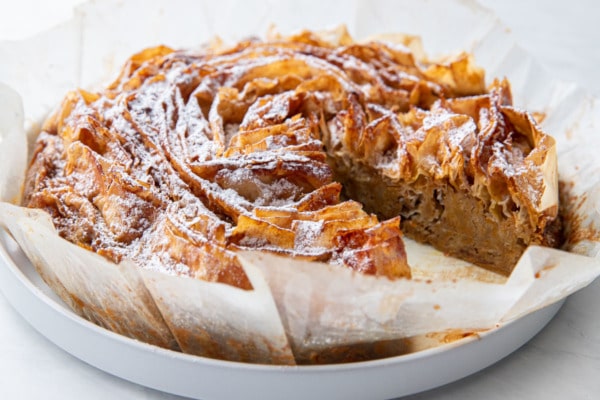
Pumpkin Ruffled Milk Pie
With crispy, ruffled layers of phyllo dough on top and a custardy, bread pudding-like interior infused with pumpkin and spices, this ruffled milk pie is a textural experience unlike anything you’ve ever had before.
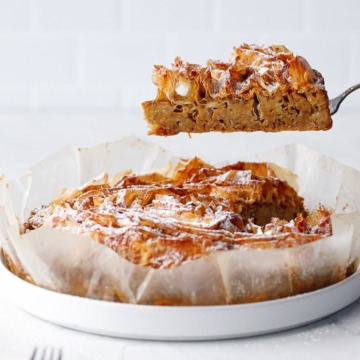
Ingredients:
- 3/4 cup clarified unsalted butter* or ghee
- 1 package (16 9-by-14-inch or 8 18-by-14-inch sheets) frozen phyllo dough, fully thawed overnight
- 1 tablespoon honey
- 3/4 teaspoon ground cinnamon
- 3/4 cup whole milk
- 1/2 cup heavy cream
- 2/3 cup canned pumpkin puree
- 3 large eggs, at room temperature
- 1/2 cup packed light brown sugar
- 1 1/2 teaspoons ground cinnamon
- 1/2 teaspoon ground ginger
- 1/4 teaspoon kosher salt
- 1/8 teaspoon freshly ground nutmeg
- 1/8 teaspoon ground cloves
- 2 teaspoons vanilla extract
- powdered sugar, for dusting
Directions:
- Preheat oven to 350 degrees F. Butter a 9-inch round by 2-inch deep cake pan. Press a sheet of wide parchment paper down into the bottom of the pan, smoothing out the bottom so it sticks and creasing the sides (it won’t lie perfectly flat, but that’s ok). Trim off any extra tall scraps, leaving parchment about 1 inch above the edge of the pan (2 inches above if your pan is shallower).
- Unroll phyllo dough on a flat work surface. Cover with a sheet of waxed paper and a slightly damp kitchen towel on top; this will help keep the dough from drying out as you work.
- Place one sheet of phyllo dough on a clean surface. Using a wide pastry brush, brush a thin layer of melted clarified butter over the entire surface of the dough.
- Loosely fold into an accordion shape along the long edge. The size of your folds will depend on the size of your phyllo; for example, I used smaller 9-by-14-inch sheets, and made alternating folds about 2 1/4 inches in size (the final shape was like an M, if that helps you visualize the process). Ideally you want the height of your folded dough to be as tall as your cake pan.
- With the raw edges facing up, roll the dough into a rough rosette shape, and place into the center of prepared cake pan. Don’t roll too tightly, as you do want to leave space in between the dough layers for the custard to go.
- Take out another sheet of phyllo dough, taking care to keep the rest of the dough covered. Brush with butter, then fold again into an accordion. Place into the cake pan and continue the spiral shape where your last piece ended.
- Continue to butter, fold, and spiral sheets of phyllo dough until the cake pan is completely filled. The dough will collapse inward a bit as it cooks, so if you can pack in another sheet or two around the outer edge it’ll bake up more evenly. I used a total of 16 smaller sheets of phyllo for my pie; for larger sheets you may only need 8 or 10.
- Combine 2 tablespoons of remaining butter with 1 tablespoon honey; rewarm for 10 of 15 seconds in the microwave if necessary. Brush top of phyllo spiral generously with butter honey mixture, then dust with cinnamon.
- Bake for 25 minutes or until phyllo is golden brown and crispy. Remove from oven and let cool while you prepare the custard.
- To prepare custard, combine milk, cream, and pumpkin puree in a saucepan. Heat over medium, stirring occasionally, until mixture begins to steam (do not let it fully boil).
- Meanwhile, while milk is heating, whisk eggs with sugar, salt and spices in a medium bowl until frothy. Spoon hot milk mixture, 1/4 cup at a time, into egg mixture, whisking vigorously as you drizzle in the hot milk. This will temper the eggs rather than cook them. Continue adding hot milk, 1/4 cup at at time, until about half of the liquid has been incorporated and mixture is warm to the touch. Pour warm egg mixture back into saucepan with remaining milk and whisk until completely incorporated. Whisk in vanilla extract.
- Pour custard into cake pan, making sure to get custard into all the nooks and crannies between the layers of phyllo dough. The custard should only come about 2/3 of the way up your phyllo dough (you want some to remain uncovered so it stays crispy).
- Place cake pan on a cookie sheet (just in case of overflow), and return to oven. Bake for 25 to 30 minutes or until phyllo is deep golden brown and custard is puffed and set but still slightly jiggly.
- Remove from oven and place pan on a wire rack to cool completely. Use the parchment to lift the entire pie out of the pan and place on a serving plate, peeling down the sides. Dust with powdered sugar before slicing and serving.
*To clarify butter, melt in a saucepan set over medium-high heat until butter starts to foam and sputter. Stir occasionally and continue to simmer until the sputtering subsides and the white milk solids sink to the bottom of the pan. This is essentially the same process as making browned butter, but we’re just not going to cook it long enough to brown. Once the solids have separated, remove from heat and let cool slightly; the solids should settle to the bottom as it cools. Carefully pour or spoon off just the clear part of the butter, leaving the milk solids behind.
Did you make this recipe?
Let us know what you think!
Leave a Comment below or share a photo and tag me on Instagram with the hashtag #loveandoliveoil.
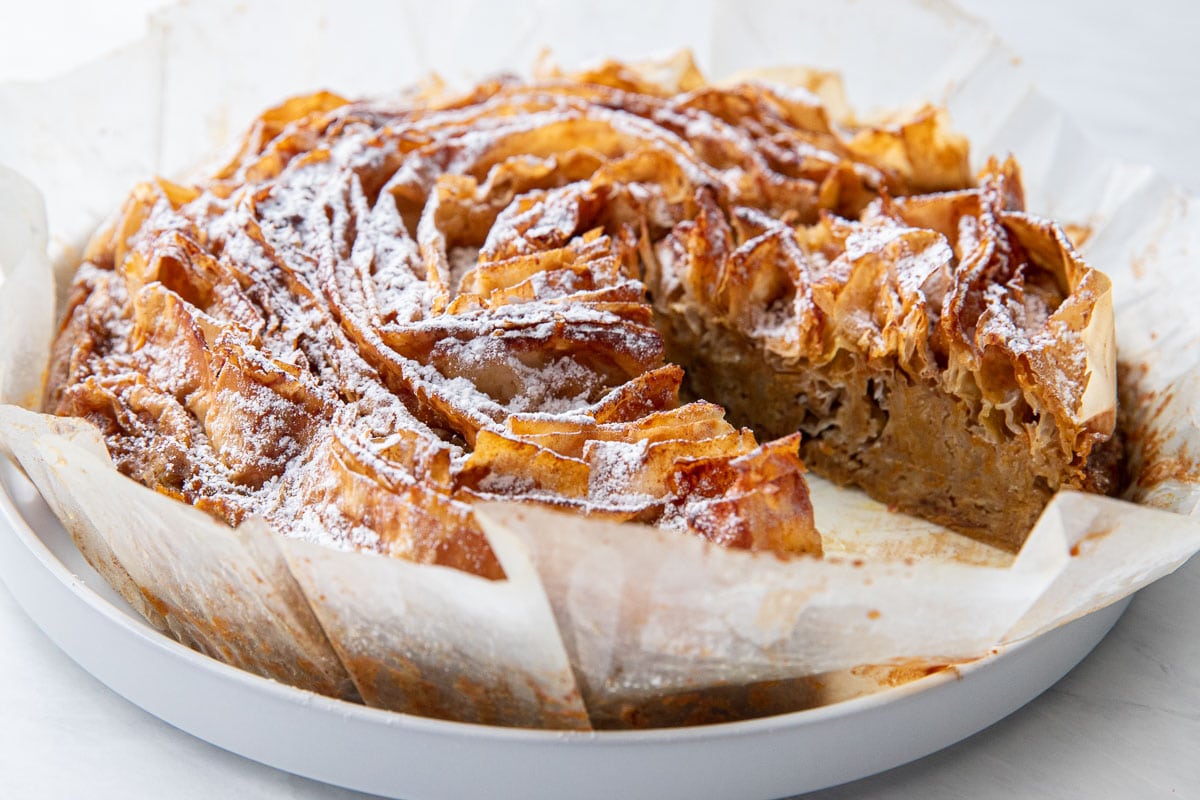
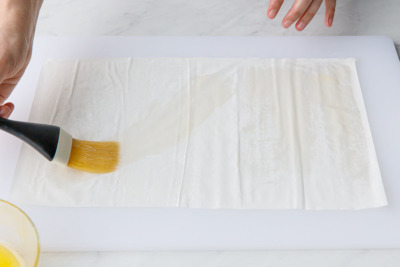
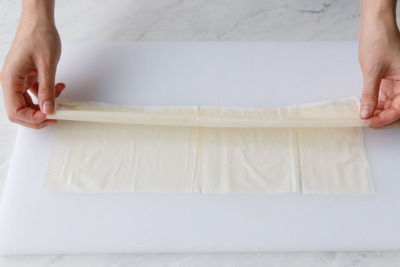
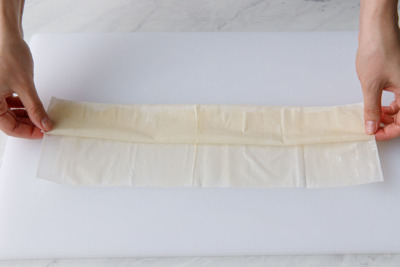
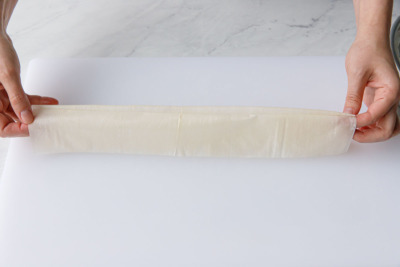
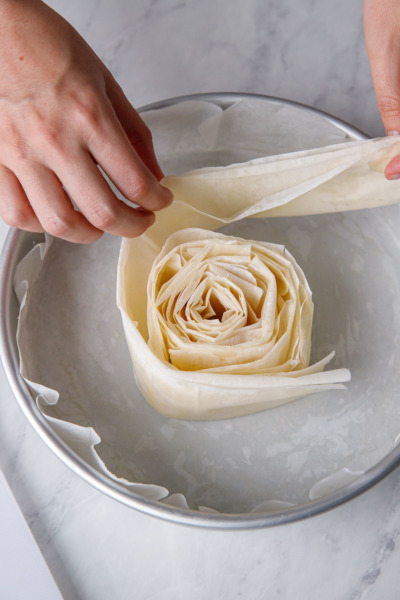
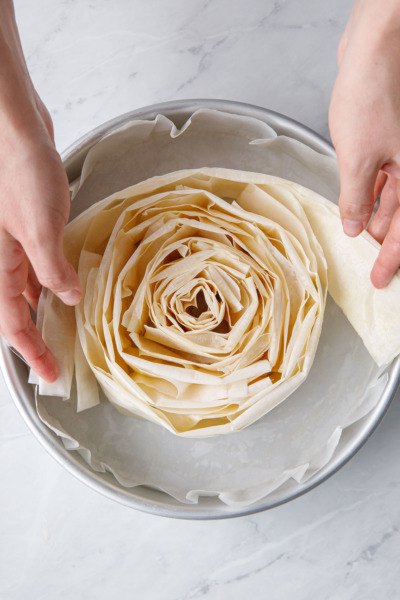
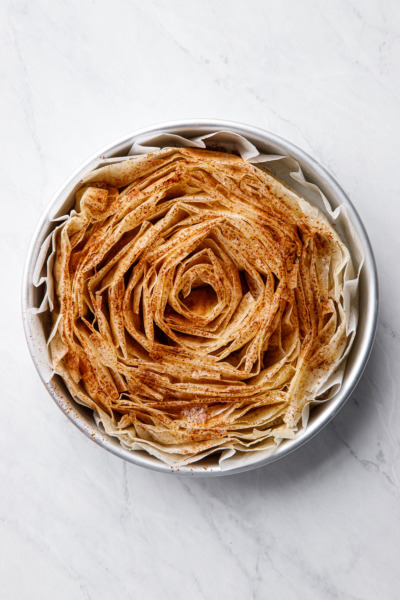

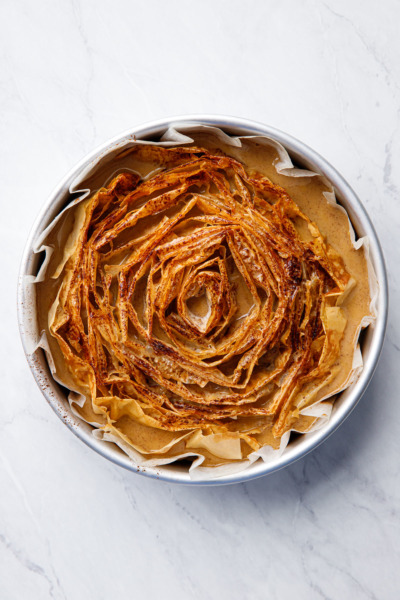
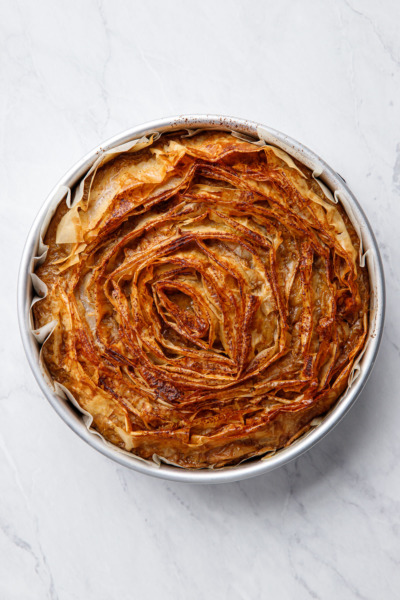
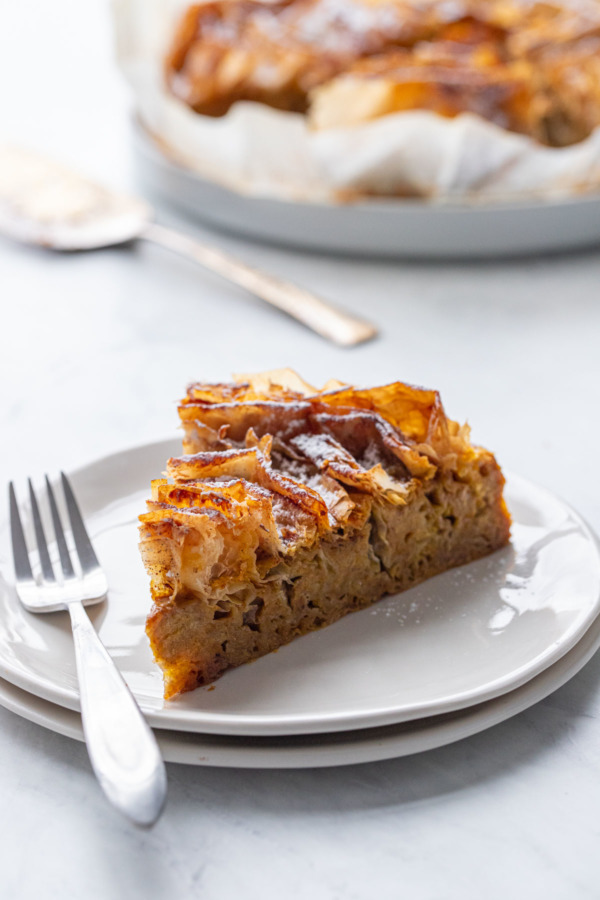
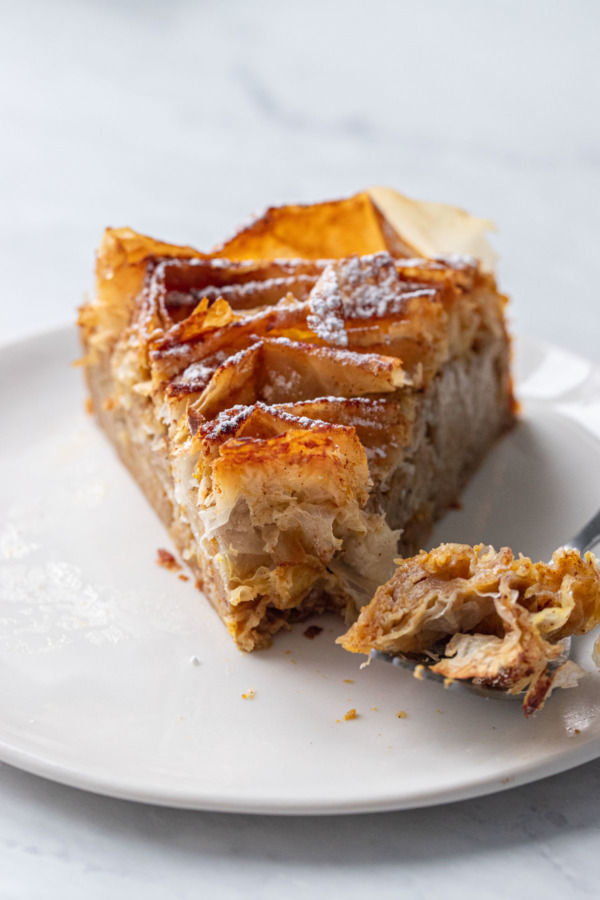
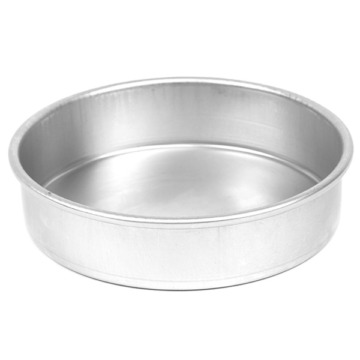
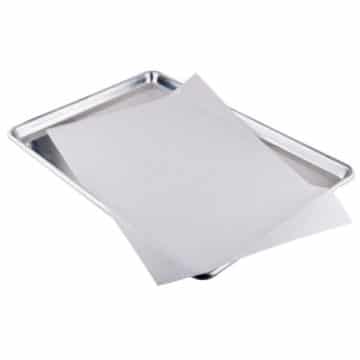
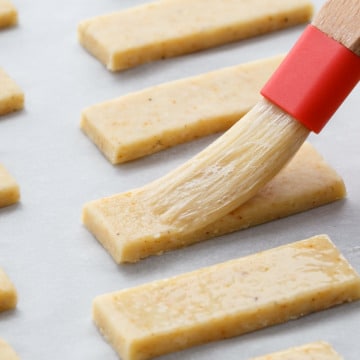
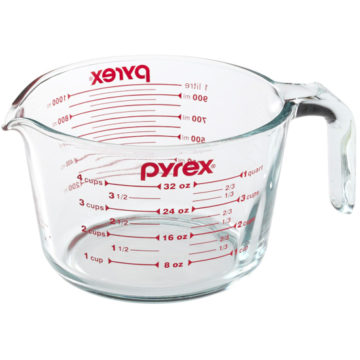
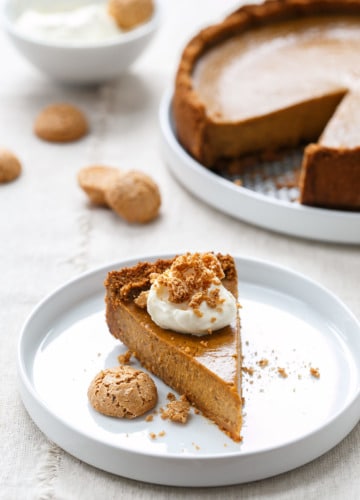
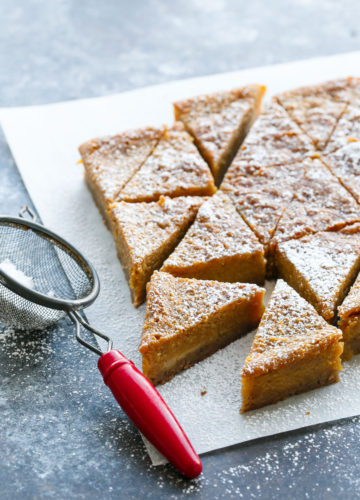
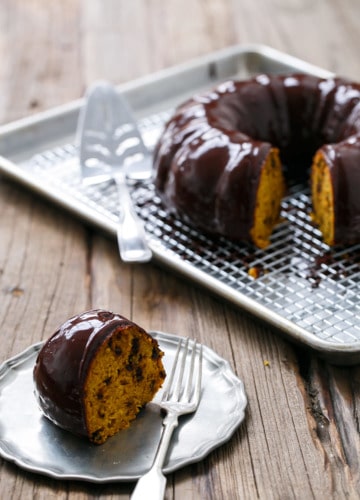
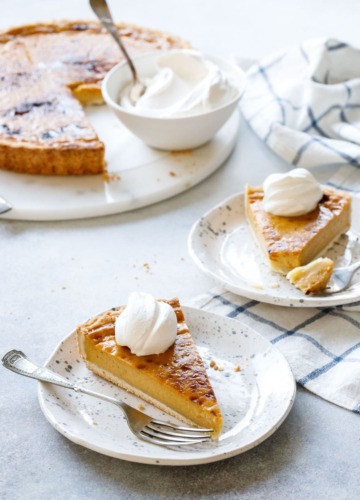
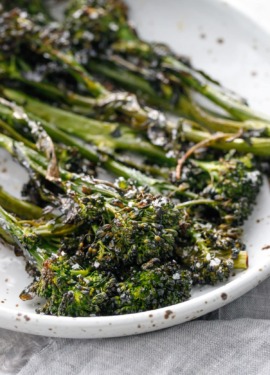
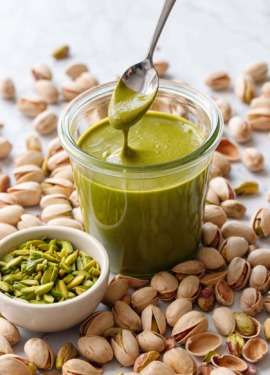
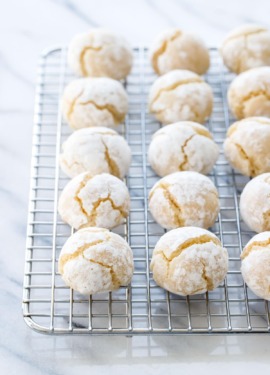
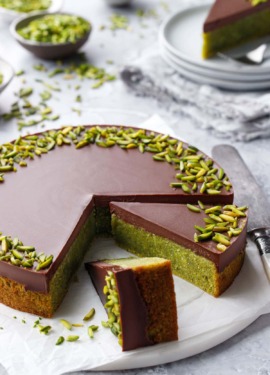
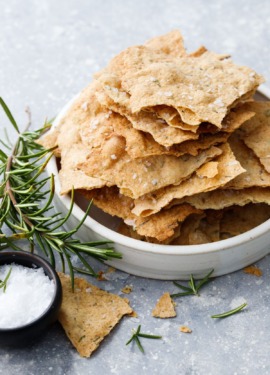

Did anyone attempt crisping this up in the oven the next day to see if that revived the top bits of phyllo? I’m dying to make this but my mom will strangle me if I try to bake something in her house on the day so I’ll have to make it the day before… but I’m determined. I’m making it regardless lol
Any guesses as to temp/time?
I’m not getting this “M” thing. Why am I making an “M”, when I’m just going to make a spiral? Am I making an “M” and then twisting the “M” on itself to make a spiral? Do I do this with every piece? I’m confused because all I see are spiral photos, no “M”. Thank you.
The M is for the folding of each individual piece of phyllo dough with butter in between each fold (like a paper fan if that helps envision it). After folding, then it is rolled into a spiral.
Should there be a layer of phyllo at the bottom of the pan?
Nope, just parchment. :)
I really want to try this on Thanksgiving. But I have make everything else. Could I mix up the pumpkin custard chill the night before and have it ready in the fridge?
Yes, I think you could definitely mix up the custard the day before!
I made this last night for Friendsgiving and it was a hit! Beautiful, delicious, and so unusual. It did collapse a bit at the edges, but still looked & tasted great. I’m planning on making it again this week for Thanksgiving… this recipe’s a keeper! (I made it in a springform pan, too which helped with sticking & serving.)
That makes me so happy to hear! So glad you enjoyed and have a lovely Thanksgiving! :)
Do you think this could be made as individual desserts! Like in a custard cup?
Definitely! As I was assembling it I was thinking you could easily make individual pies in a muffin tin for example, one rosette per cup. A ramekin or mini springform pan would work well too!
This is an edible work of art! Simply gorgeous! And anything with phyllo dough is pretty amazing. Going to attempt this for Thanksgiving.
Oooooo! This might be perfect for us to bring to our friends’ potluck Thanksgiving this year! I can see how it might be too much for any host to manage though. There will be other pies for the traditionalist and/or timid guests.
This is GORGEOUS! I totally want to make this for Thanksgiving. It looks amazing, and what a fun alternative to regular pumpkin pie!
I literally just had an apple version of this at a restaurant over the weekend!!! And immediately wanted to figure out how to make it. Seriously perfect timing, haha! This is gorgeous Lindsay :)
wonderful alternative, wow, huge creativity bonus for this, best alt-pumpkin pie I’ve seen, thank you